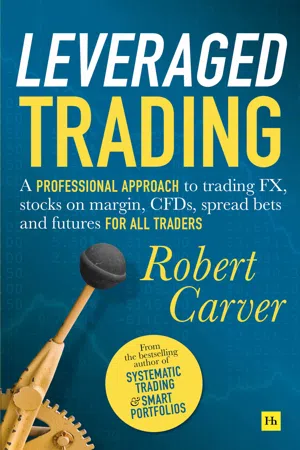
Leveraged Trading
A professional approach to trading FX, stocks on margin, CFDs, spread bets and futures for all traders
Robert Carver
- English
- ePUB (adapté aux mobiles)
- Disponible sur iOS et Android
Leveraged Trading
A professional approach to trading FX, stocks on margin, CFDs, spread bets and futures for all traders
Robert Carver
À propos de ce livre
With the right broker, and just a few hundred dollars or pounds, anyone can become a leveraged trader. The products and tools needed are accessible to all: FX, a margin account, CFDs, spread-bets and futures.But this level playing field comes with great risks. Trading with leverage is inherently dangerous. With leverage, losses and costs – the two great killers for traders – are magnified.This does not mean leverage must be avoided altogether, but it does mean that it needs to be used safely. In Leveraged Trading, Robert Carver shows you how to do exactly that, by using a trading system. A trading system can be employed to tackle those twin dangers of serious losses and high costs.The trading systems introduced in this book are simple and carefully designed to use the correct amount of leverage and trade at a suitable frequency. Robert shows how to trade a simple Starter System on its own, on a single instrument and with a single rule for opening positions.He then moves on to show how the Starter System can be adapted, as you gain experience and confidence. The system can be diversified into multiple instruments and new trading rules can be added. For those who wish to go further still, advice on making more complex improvements is included: how to develop your own trading systems, and how to combine a system with your own human judgement, using an approach Robert calls Semi-Automatic Trading.For those trading with leverage, looking for a way to take a controlled approach and manage risk, a properly designed trading system is the answer. Pick up Leveraged Trading and learn how.
Foire aux questions
Informations
Part One: Fundamentals
Introduction to leveraged trading
What is leverage?
| I begin with $100,000 in cash. | |
| I borrow $400,000 | This gives a total of $500,000 in buying power. |
| I buy a $500,000 house | My starting housing equity is the value of the house, less the outstanding loan: $500,000 – $400,000 = $100,000. For this simple example we ignore any costs such as agent’s commissions or taxes. |
| After a year I have earned rent and paid interest | I earn $20,000 in rent and pay $16,000 in interest. This is a net return of $4,000. |
| The value of the house has gone up by 10% | My equity after one year is the value of the house, less the outstanding loan: $550,000 – $400,000 = $150,000. I have made $50,000 profit from the price gain. |
| Total profit is $54,000. |